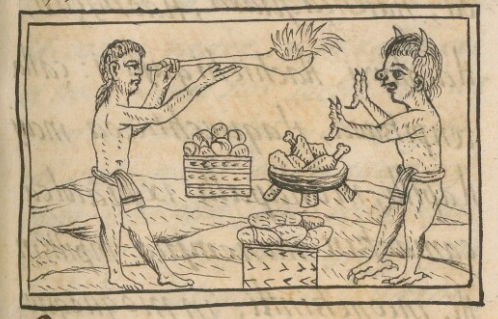iztihuihuiyac (FCbk6f28r)
This iconographic example featuring a figure with long nails or claws (iztihuihuiyac) is included in this digital collection for the purpose of making potential comparisons with hieroglyphs of nails and claws. The term selected for this example comes from the keywords chosen by the team behind the Digital Florentine Codex. There is no gloss. The figure with the bird-like claws is apparently a human-horned owl (tlacatecolotl). The two front claws are raised in a threatening way.
Stephanie Wood
Eagle claws (cuauhiztetl) do figure somewhat prominently in glyphs, seen for example on a war shield, as a pendant, and they are found in painted scenes of Nahua religious activities. Tetepon (from tetepontli, animal claw) is known as a personal name. The nail (itztitl) of a claw can appear in the colors of flint knives (red and white), perhaps suggesting a role in bloodletting for religious offerings.
Stephanie Wood
1577
Jeff Haskett-Wood
uña, garra, afilada, larga, pie, pata, demonio, demon, diablo, devil
iztihuihuiyac, one with long nails or claws, https://nahuatl.wired-humanities.org/content/iztihuihuiyac
alguien con uñas o garras largas
Stephanie Wood
Available at Digital Florentine Codex/Códice Florentino Digital, edited by Kim N. Richter and Alicia Maria Houtrouw, "Book 6: Rhetoric and Moral Philosophy", fol. 28r, Getty Research Institute, 2023. https://florentinecodex.getty.edu/en/book/6/folio/28r/images/0 Accessed 3 July 2025.
Images of the digitized Florentine Codex are made available under the following Creative Commons license: CC BY-NC-ND (Attribution-NonCommercial-NoDerivs 4.0 International). For print-publication quality photos, please contact the Biblioteca Medicea Laurenziana ([email protected]). The Library of Congress has also published this manuscript, using the images of the World Digital Library copy. “The Library of Congress is unaware of any copyright or other restrictions in the World Digital Library Collection. Absent any such restrictions, these materials are free to use and reuse.”








